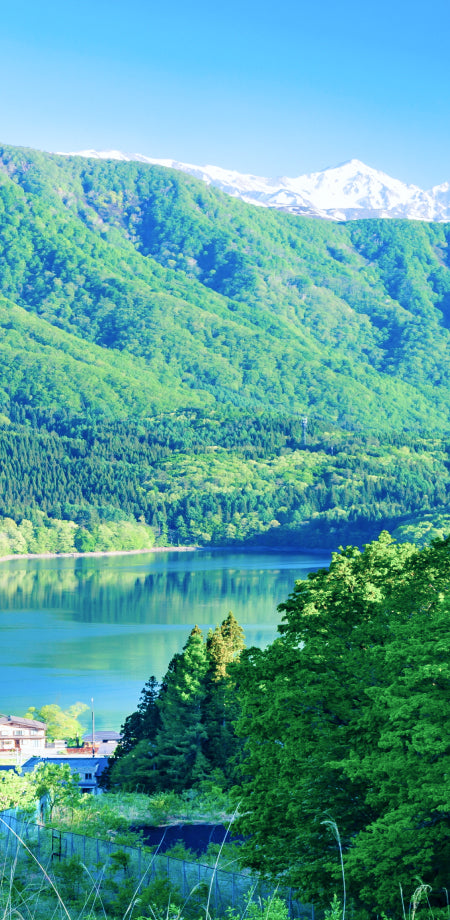投稿日:
更新日:
ShinshuEat meat from it! Part 2
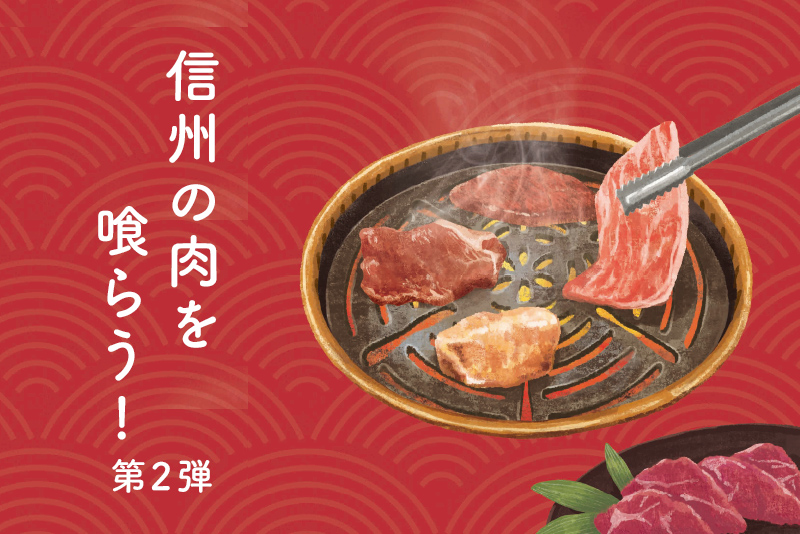
Because there is no sea, various meat cultures have been cultivated in each region. Nagano prefecture. This is the second installment that brings you a meat culture that is rooted in various places, including mutton culture that is connected to men shepherds, Genghis Khan, horse meat culture that is based on farming horses, and internal foods.
Vol.1 The tradition and passion of the lamb culture protected by the "Sheep Town"
Vol.2 The best Yakiniku in Japan! SouthShinshuEnjoy the charm of lamb and internal foods
Vol.3 A taste of locality that is the old and new knowledge of the Meiji-based establishment
Vol.1 "The Town of Sheep"ShinshuThe tradition and passion of the lamb culture protected by Shinmachi
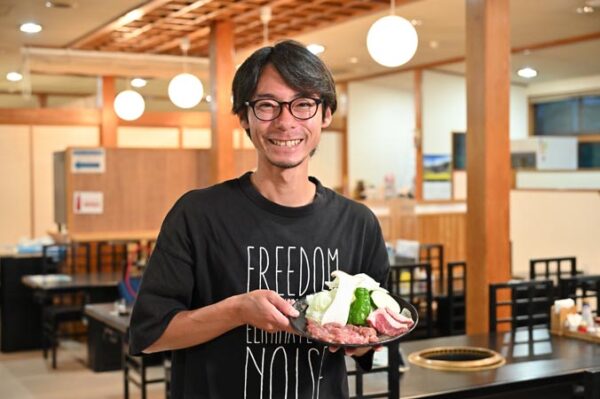
ShinshuFudo Onsen Sagiriso
Director: Hiroki Koyama
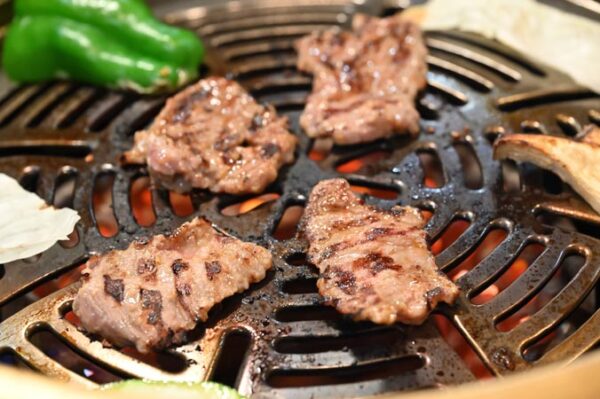
In Japan, pre-war, shepherds were encouraged nationwide as a national policy for munitions. Nagano The breeding was also popular in the prefecture. This is where the culture of eating mutton has taken root. actually Nagano The prefecture is known as the "Genghis Khan Kingdom" that is lined with Hokkaido.
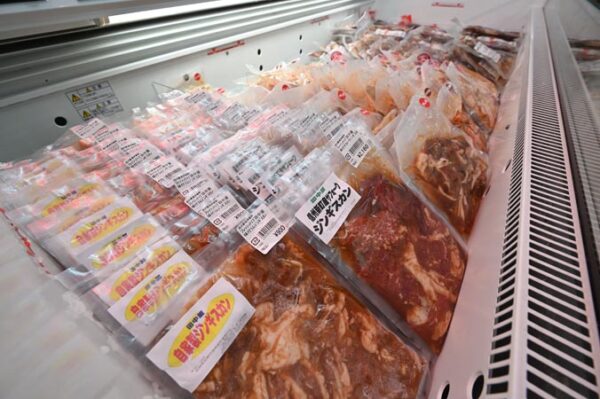
However, more than 99% of the lamb currently available in Japan are imported meat. Even now that domestic lamb has become rare, it is known as the "shoulder town" that grows sheep in the community.Nagano CityShinshuThis is Shinmachi. Along National Route 19 in the region, there are specialists who serve Jingisu Khan, called the "Ginghisu Khan Kaido," and the community unites the culture of lamb.

Sheep raising to collect wool began in this area in 1930. In addition to the fact that the cool, dry climate was suitable for breeding, and the remaining sheep sachets and bean shells from the once-popular silkworms became feed, leading to an increasing number of farmers who kept sheep. It is said that in the late 1940s there were as many as 4,000 sheep in the area.
In 1936, the deliciousness of the seasoned Jingisu Khan, which was pickled with sauce, was recognized at a cooking seminar, and in 1951, the Tourism Association entertained visitors at Jingisu Khan.ShinshuThe reputation of Shinmachi's lamb has spread even more.
However, from around 1955, the number of livestock farmers decreased dramatically due to the rise of chemical fibers. In the 1960s and 1980s, transportation became better, and despite the increase in the number of Jingisu Khan restaurants as people traveled, there were almost no sheep in the town.
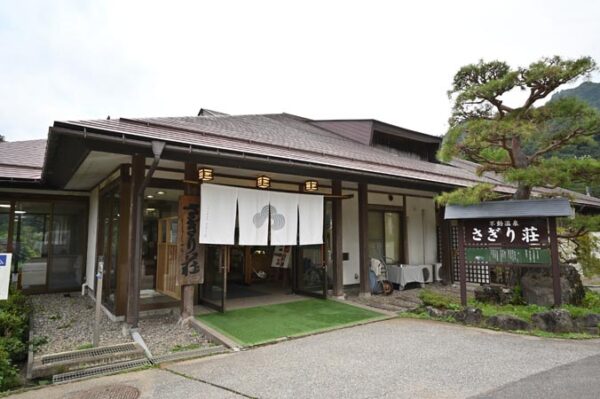
▲In 2010ShinshuShinmachiNagano CityAfter being merged with Sagiri-so, Sagiri-so, has been converted to a designated city management facility. It is a hot spring inn, but it is also possible to take a day trip or use it for meals.
In an attempt to somehow restore locally produced lamb, the Suffolk variety for meat was introduced in 1982. Unlike the Coridale and Merinaudes, which are used to cut wool, which have been raised in town up until now, this is a meat variety native to England, and is characterized by a black face.
thisShinshuThe only restaurant in the area where you can eat Suffolk meat from Shinmachi is popular among foodies, and was founded as a town-run facility in 1973.ShinshuFudo Onsen Sagiri-so." This is a recreational facility located on the west side of the Jingisu Khan Road.
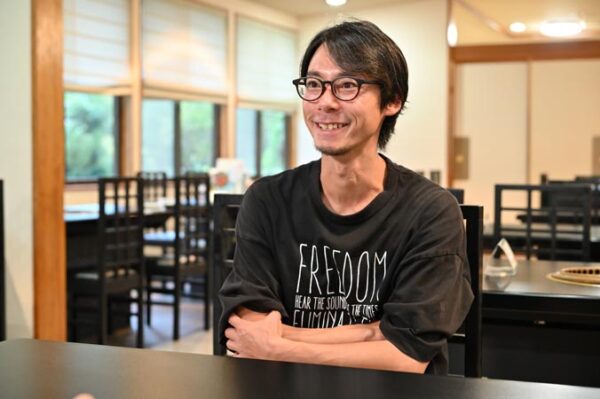
Our particular preference is to offer "hogget" Suffolks for ages 1-2, between lamb and mutton (ages 2 and above).
"The Hoggets are different from beef or pork, and have the charm of lamb's original flavor, lack of fat, and tenderness. As they sell "Sheep Town," we offer hoggets that convey the best of the quality of lamb."
This is what the director, Koyama Hiroki, says. In recent years, due to the aging of producers and the COVID-19 pandemic, the number of Suffolk breeding in the region has decreased further, so Sagiri-so made a point, and from 2021 began raising approximately 160 Suffolks using the former town-run farm.
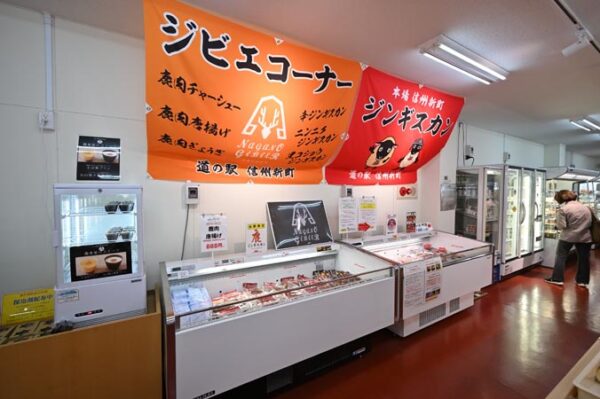
▲Local road station "ShinshuThere is also a special Jingisukan sales corner in Shinmachi.
"The image of sheep grazing is that they are grazing, but our company manages them in a livestock barn like Japanese beef, and feeds them with dried grass, grains, beer sardines, okara, apples, etc. There is no crunch or smell from the green grass, and the meat is really delicious."
Born and raisedShinshuMr. Koyama from Shinmachi. Suffolk has always been a valuable thing that can only be eaten at special occasions, but Genghis Khan, seasoned with imported lamb, is said to have often eaten at home, and he says, "When it comes to yakiniku, it was Jinghis Khan."

▲Assorted Jingisu Khan and locally produced Suffolk served at Sagiri-so
ShinshuThe characteristic of Shinmachi's Jingisu Khan is that the sauce is marinated in the meat in advance. Each of the 10 stores on the Genghis Khan Kaido has a special sauce, and it seems that they often have a strong flavor, but at Sagiri-so, we combine 14 types of meat, including garlic, ginger, grated apples and onions, to give it a mild finish so that you can enjoy the lamb itself. Another attraction of "Sagiri-so" is that you can enjoy this special dish, Jingisu Khan.
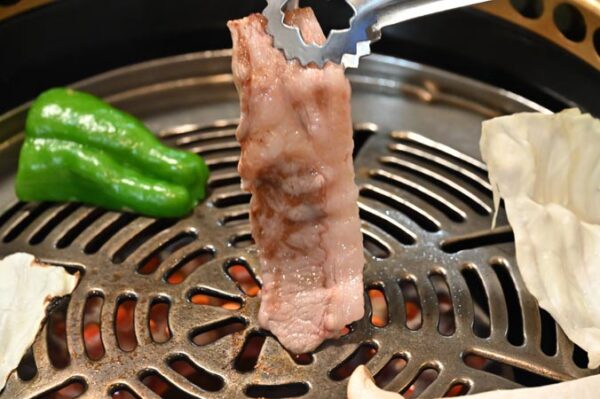
▲Local road station "ShinshuThere is also a special Jingisukan sales corner in Shinmachi.
It seems that lamb can be eaten even rare, but Koyama said, "If you grill it thoroughly, the excess fat will be moderately reduced, so it's recommended," he said.サフォークも焼きすぎない程度に焼き、岩塩でシンプルに味わいます。 This allows you to thoroughly enjoy the unique deliciousness of lamb, the more you chew it, the more you will be able to thoroughly enjoy it.
"Suffolk, an improved meat variety, is not good at giving birth and raising children, and although sheep are difficult to raise, such as parasite infections,ShinshuIt's a Shinmachi culture, and the meat is first class. There are many repeat customers who come to eat from afar. We hope to continue to preserve this food culture as an ingredient that makes use of the strengths of the region."
Suffolk and Jinghis Khan convey the history and culture of the land. Koyama's words convey the pride and enthusiasm of being a follower of that tradition.

ShinshuFudo Onsen Sagiriso
address:Nagano CityShinshu300-1 Shinmachi Hihara Nishi
phone:026-264-2103
http://www.sagirisou.com/
*This article is information as of December 2022. Please note that the products we carry may have changed.
Vol.2 The best Yakiniku in Japan! SouthShinshuEnjoy the charm of lamb and internal foods

Iida City Public Relations Brand Promotion Division Ichise Tomoaki
SouthShinshuHirasawa Shinichi, Livestock Brand Promotion Council

▲SouthShinshuMinami is a popular promotion of the high quality and distinctive meat culture.ShinshuHirazawa Shinichi of the Livestock Product Brand Promotion Council
SouthShinshuIt is also a land where the sheep culture of the sheep breeding of ancient sheep is rooted in. Iida City in particular is known as the "the largest Yakiniku town in Japan" with the largest number of yakiniku restaurants per 10,000 people, and every restaurant is lined with mutton.
"The South has been highly regarded nationwide in this region.ShinshuLivestock production is thriving, including beef and many branded pigs, but it is said that "Iida Yakiniku" started with sheep. Nowadays, the lamb served in stores have become imported, but wool was originally produced, and the culture of eating sheep has been established because they were eating old sheep as a source of protein."
This is what Iida City Agricultural Division says, "Minami"ShinshuThis is Hirasawa Shinichi from the Secretariat of the Livestock Brand Promotion Council.

▲ Ichise Tomoaki of Iida City's Public Relations Brand Promotion Division says, "Mutton and Jingisu Khan are familiar to citizens."
"I'm sure some people don't like the unique flavor of mutton, but Iida residents like it, and they like it, and they don't order mutton at yakiniku restaurants. That's because it's been eaten in the local area for a long time," says Ichise Tomoaki, a member of Iida City's Public Relations Brand Promotion Division.
The yakiniku culture connected to this mutton is so rooted in the community that it has a "delivery yakiniku" service where butchers carry yakiniku tools sets with just a phone call.

▲The mutton is SouthShinshuCan't miss out on Yakiniku at yakiniku
There are various theories about the circulation of mutton (Ginghis Khan) in this area, but according to one theory, it is said that people on the Korean Peninsula who came to this area in the 1930s and 1940s were grilling and eating livestock lamb kneaded with their own sauce made from chili peppers and garlic. Until then, it was apparently the mainstream in the region to eat meat by boiling it in a pot, but from here onwards it is said that a culture of marinating lamb in sauce and grilling it spread.

As the culture of eating yakiniku at home took root, yakiniku restaurants gradually increased in the region since the 1940s. In Iida City, it is common for yakiniku to be held as a set in various situations where people gather, such as sports events and sports day events, as well as for comfort parties for grass cutting and social gatherings, as well as active community center activities in the Iida Shimoina area.
Also, before the COVID-19 pandemic, he often went to a yakiniku restaurant for the first party, and after the second party, when the night ended, he often went to a yakiniku restaurant for the final after-party. slowTimesThe fact that there are many yakiniku restaurants that are open to the public is unique to this area, where yakiniku culture is rooted.

▲ "Iida Yakiniku Day" opened on November 29th, 2022ShinshuIida Yakiniku Research Institute"
しかし、市民にとって焼肉はあまりに身近だったことから、“日本一の焼肉の街”であることは、意外にも行政でも明確に把握していなかったそう。 It was a surprise that it was made aware of it.
We received information from an employee from Bihoro, Hokkaido, where we became friends at a local government employee training session held in 2011, about an article published by the Hokkaido Shimbun the following year, 2012. In a special feature on Yakiniku in Kitami City, Hokkaido, the number of Yakiniku stores per 10,000 people was introduced as the second largest in the country after Iida City, and Iida City, that is, the number one in the country.
After that, in 2015, the group was called "South"ShinshuCattle Brand Promotion Council (now Minami)ShinshuThe Livestock Brand Promotion Council has verified information on the town page. It has officially confirmed that Iida City is number one in the country and made it public. Since then, it has been featured in various media both inside and outside the region as the "nice yakiniku town in Japan."
In 2020, the Iida Shimoina Meat Association (now Minami)ShinshuThe Meat Association and local Maruman Co., Ltd. applied to the Japan Anniversary Association and established November 29th as "Iida Yakiniku Day." In 2021, the Iida Yakiniku World Record Challenge Executive Committee, a volunteer citizen, played yakiniku on a 11m29cm iron plate, and the "world's longest iron plate" was recognized as the world's record.
And in 2022,ShinshuSecure Foods is in the city centreShinshuEstablished the Iida Yakiniku Research Institute. It is open from 6am to midnight as a new base that will provide information on yakiniku restaurants, sell processed products, display historical documents about Iida's yakiniku, and display the "world's longest surety plate." Another characteristic of Iida Yakiniku is that private companies take the initiative to lead the local culture, rather than being led by government.

▲ "Kuromotsu" is a menu that you can only enjoy unless you visit the area, where you eat the black skin of beef internal organs. It is served boiled and cooked on a teppan to the texture you like.
Another attractive feature of Iida Yakiniku is the innards of hormones. There was a slaughterhouse in the area, and fresh internal organs were easy to obtain, so yakiniku restaurants have their own unique menus, such as "black motsu," which are not found in other regions, and "boiled olive," made from boiled hormones.

Even within Iida City, a fierce battleground for yakiniku,Shinshu"Wagyu Beef Buying Fuemon" is a place where you can enjoy both traditional Iida yakiniku, such as mutton and "black motsu" along with beef. SouthShinshuBeef is mainly distributed in the Kansai region, and although it is hard to find in the local area, Minami has been certified as A5 rank, the highest grade of domestic beef.ShinshuOnly one cow is purchased and served. In addition to establishing traceability, it also has a wide selection of valuable parts.

▲ "Kuromotsu" is a menu that you can only enjoy unless you visit the area, where you eat the black skin of beef internal organs. It is served boiled and cooked on a teppan to the texture you like.
The characteristics of "Fuemon" can also be seen in the sauce. In Iida City, many people are so particular about yakiniku sauce that it is said that "each family has a secret sauce," but the restaurant offers two types: dry and sweet. Both are based on tamari soy sauce blends, and the dryness is made with garlic, which is often found in yakiniku restaurants in Iida City, while the sweetness is Minami.ShinshuI use fruit and no garlic.
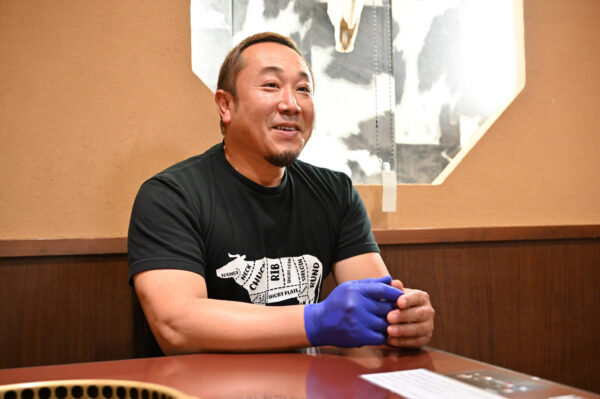
▲Sasaki-san opened "Fuemon" in 2018 after a yakiniku lover was so popular that he eats yakiniku three days a week.
"The dry sauce goes well with internal organs such as black motsu and mutton, and the sweet taste stands out for the beef. However, even in internal organs, it is recommended to add green onions and garlic to the sweet sauce for fatty hormones such as shimacho."
This is what the representative of the group Sasaki Hiroshi said. The most popular menu item these days is mixed hormones, but Minami is the bestShinshuPeople who visit to find beef say that the assorted top-kalbi platter, rib loin and top-haired top-haired top-haired top-haired top-haired top-haired top-haired top-haired top-haired top-haired top-haired top-haired top-haired top-haired top-haired top-haired top-haired top-haired top-haired top-ha Additionally, the finest beef tongue part, "Tangen," is a dish with many fans, where you can enjoy the softness and juiciness of thick sliced beef tongue.
"As expected from the SouthShinshuThe beef is tasty. All meat is tastier if grilled with beef fat, so you should cook thick meat slowly."

▲ "Mixed Hormon" is one of the popular menu items at Fuemon.
In recent years, "If you've visited Iida, then Minami is the place to go.ShinshuThe restaurant is visited by many people from outside the prefecture, saying, "I want to eat beef." It adds color to the rich variety of "Iida Yakiniku".

"We would like to work together with restaurants and businesses, citizens and the government to further promote the yakiniku town," said Ichise and Hirasawa. As a government agency, we are enthusiastic about promoting Iida's Yakiniku culture through connections between the city and abroad, by working with local governments in other prefectures, such as Kitami City, Hokkaido, where there are also many yakiniku restaurants.
SouthShinshuLivestock Product Brand Promotion Council
Address: 281 Ding Dong Ding, Iida City, Inside Production Promotion Section, Agricultural Division
phone:0265-21-3217
https://msgyu.com/
Buying a single Japanese beef, Fuemon
Address: Top Hills Ginza 1F, 3-1-1 Ginza, Iida City
phone:0265-52-9029
https://fuemon.com/
*This article is information as of October 2022. Please note that the products we carry may have changed.
Vol.3 A taste of locality that is the old knowledge of the new and new locality that is brought to you by a long-established establishment founded in the Meiji era

Mitsuda Shokudo
Matsuda Michihiko and Mariko

▲The culture of eating horse meat Nagano It takes root all over the prefecture, but "otaguri" can be eaten in Minami.Shinshuonly. The seasoning varies depending on the store, including miso, salty, and soy sauce flavors.
SouthShinshuThe meat culture of yakiniku is not limited to yakiniku. SouthShinshuSince it was also a production area for farming horses, it is also characterized by the widespread use of horse meat dishes. This area is especially unique to the fact that you can eat otaguri, a stewed horse intestines that are slowly simmered. The name of the dish comes from the fact that it was slurped when washing the long intestines of horses, a herbivore, and although it has a unique flavor, it is different to whether it is liked or not, it seems that many people in the local area prefer it as a snack with alcohol.

Mitsuta Shokudo, founded in 1887, is a long-established restaurant that serves such "otaguri". While many restaurants in the city moved due to the huge fire that occurred during the Meiji period, the restaurant continues to operate in an unchanged location since its founding.

"We have been a carp specialty restaurant for many years, but in response to local demand, our previous father gradually began to serve dishes that can only be enjoyed in the Iida and Shimoina regions."
This is what Matsuda Michihiko, the fifth generation. He works together with his wife Mariko to share a food culture rooted in the community.
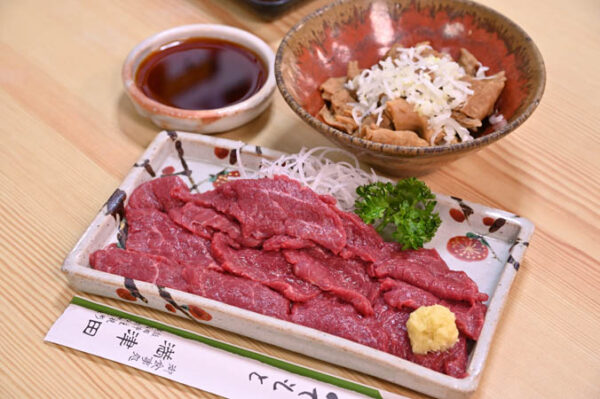
▲The "Otaguri" is a miso-stewed type. The beautiful fresh red horse sashimi is always served freshly cut
Apparently the originator began to eat local cuisine other than carp cuisine was the opening of the Chuo Expressway (1975: Komagane IC to Nakatsugawa IC). As travelers began to visit, they wanted to offer something more local and responded to comments from those around them saying that they would like to serve local cuisine such as horse sashimi, bee sparrows, and worms. "Otaguri" was apparently not on the restaurant's menu when Michihiko was a child, but it was one of the things that the previous generation started.
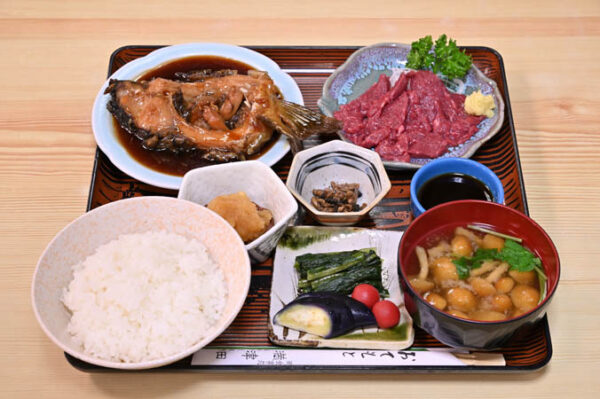
▲The Inaka Set Meal is a set meal where you can enjoy local dishes, delicacies, and local ingredients from Iida and Shimoina, including horse sashimi, stewed carp, and bee-cup. The pickles of "Gensuke Kabuna" in the foreground
"We have changed our menu according to the times, but have cherished local ingredients to preserve the local flavor.Shinshuis a place full of food ingredients.料理人としてはやりがいがありますね」
As Michihiko said, the restaurant also serves as a set meal, with the hope that people can enjoy local flavors such as carp dishes, "otaguri" and horse sashimi at once. We value freshness in horse sashimi and focus on distribution routes, such as purchasing from reliable business partners. Also, "Gensuke Kabuna" and "Shimoguri Imo" are only available locally.ShinshuIt is Michihiko's belief that he also uses traditional vegetables as much as possible.
The meat culture and local taste cultivated throughout history have become the charm of the region.

Mitsuda Shokudo
Address: Shunnocho 1, Iida City
phone:0265-22-0437
https://www.matsudashokudou.com/
*This article is information as of December 2022. Please note that the products we carry may have changed.















